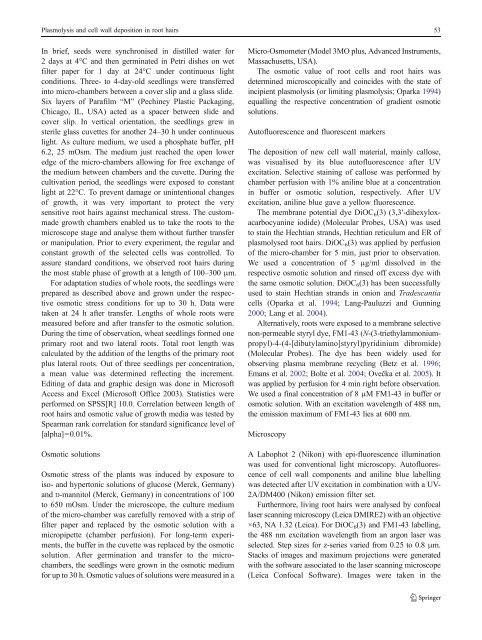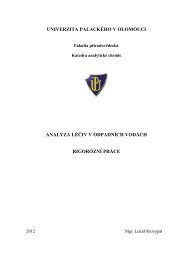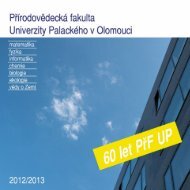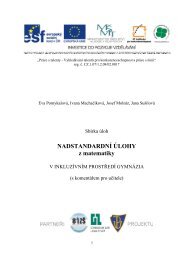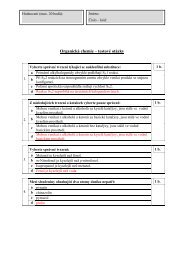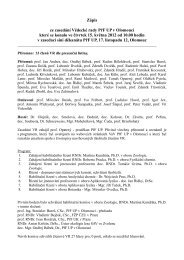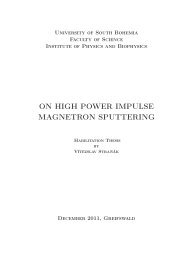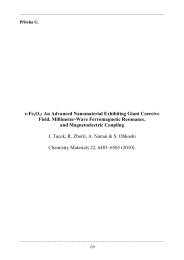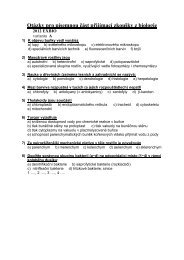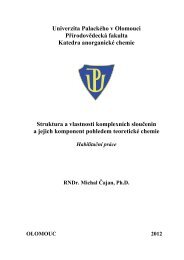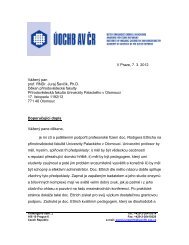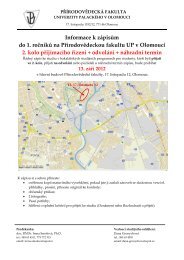A comparative structural analysis of direct and indirect shoot ...
A comparative structural analysis of direct and indirect shoot ...
A comparative structural analysis of direct and indirect shoot ...
You also want an ePaper? Increase the reach of your titles
YUMPU automatically turns print PDFs into web optimized ePapers that Google loves.
Plasmolysis <strong>and</strong> cell wall deposition in root hairs 53<br />
In brief, seeds were synchronised in distilled water for<br />
2 days at 4°C <strong>and</strong> then germinated in Petri dishes on wet<br />
filter paper for 1 day at 24°C under continuous light<br />
conditions. Three- to 4-day-old seedlings were transferred<br />
into micro-chambers between a cover slip <strong>and</strong> a glass slide.<br />
Six layers <strong>of</strong> Parafilm “M” (Pechiney Plastic Packaging,<br />
Chicago, IL, USA) acted as a spacer between slide <strong>and</strong><br />
cover slip. In vertical orientation, the seedlings grew in<br />
sterile glass cuvettes for another 24–30 h under continuous<br />
light. As culture medium, we used a phosphate buffer, pH<br />
6.2, 25 mOsm. The medium just reached the open lower<br />
edge <strong>of</strong> the micro-chambers allowing for free exchange <strong>of</strong><br />
the medium between chambers <strong>and</strong> the cuvette. During the<br />
cultivation period, the seedlings were exposed to constant<br />
light at 22°C. To prevent damage or unintentional changes<br />
<strong>of</strong> growth, it was very important to protect the very<br />
sensitive root hairs against mechanical stress. The custommade<br />
growth chambers enabled us to take the roots to the<br />
microscope stage <strong>and</strong> analyse them without further transfer<br />
or manipulation. Prior to every experiment, the regular <strong>and</strong><br />
constant growth <strong>of</strong> the selected cells was controlled. To<br />
assure st<strong>and</strong>ard conditions, we observed root hairs during<br />
the most stable phase <strong>of</strong> growth at a length <strong>of</strong> 100–300 μm.<br />
For adaptation studies <strong>of</strong> whole roots, the seedlings were<br />
prepared as described above <strong>and</strong> grown under the respective<br />
osmotic stress conditions for up to 30 h. Data were<br />
taken at 24 h after transfer. Lengths <strong>of</strong> whole roots were<br />
measured before <strong>and</strong> after transfer to the osmotic solution.<br />
During the time <strong>of</strong> observation, wheat seedlings formed one<br />
primary root <strong>and</strong> two lateral roots. Total root length was<br />
calculated by the addition <strong>of</strong> the lengths <strong>of</strong> the primary root<br />
plus lateral roots. Out <strong>of</strong> three seedlings per concentration,<br />
a mean value was determined reflecting the increment.<br />
Editing <strong>of</strong> data <strong>and</strong> graphic design was done in Micros<strong>of</strong>t<br />
Access <strong>and</strong> Excel (Micros<strong>of</strong>t Office 2003). Statistics were<br />
performed on SPSS[R] 10.0. Correlation between length <strong>of</strong><br />
root hairs <strong>and</strong> osmotic value <strong>of</strong> growth media was tested by<br />
Spearman rank correlation for st<strong>and</strong>ard significance level <strong>of</strong><br />
[alpha]=0.01%.<br />
Osmotic solutions<br />
Osmotic stress <strong>of</strong> the plants was induced by exposure to<br />
iso- <strong>and</strong> hypertonic solutions <strong>of</strong> glucose (Merck, Germany)<br />
<strong>and</strong> D-mannitol (Merck, Germany) in concentrations <strong>of</strong> 100<br />
to 650 mOsm. Under the microscope, the culture medium<br />
<strong>of</strong> the micro-chamber was carefully removed with a strip <strong>of</strong><br />
filter paper <strong>and</strong> replaced by the osmotic solution with a<br />
micropipette (chamber perfusion). For long-term experiments,<br />
the buffer in the cuvette was replaced by the osmotic<br />
solution. After germination <strong>and</strong> transfer to the microchambers,<br />
the seedlings were grown in the osmotic medium<br />
for up to 30 h. Osmotic values <strong>of</strong> solutions were measured in a<br />
Micro-Osmometer (Model 3MO plus, Advanced Instruments,<br />
Massachusetts, USA).<br />
The osmotic value <strong>of</strong> root cells <strong>and</strong> root hairs was<br />
determined microscopically <strong>and</strong> coincides with the state <strong>of</strong><br />
incipient plasmolysis (or limiting plasmolysis; Oparka 1994)<br />
equalling the respective concentration <strong>of</strong> gradient osmotic<br />
solutions.<br />
Aut<strong>of</strong>luorescence <strong>and</strong> fluorescent markers<br />
The deposition <strong>of</strong> new cell wall material, mainly callose,<br />
was visualised by its blue aut<strong>of</strong>luorescence after UV<br />
excitation. Selective staining <strong>of</strong> callose was performed by<br />
chamber perfusion with 1% aniline blue at a concentration<br />
in buffer or osmotic solution, respectively. After UV<br />
excitation, aniline blue gave a yellow fluorescence.<br />
The membrane potential dye DiOC 6 (3) (3,3′-dihexyloxacarbocyanine<br />
iodide) (Molecular Probes, USA) was used<br />
to stain the Hechtian str<strong>and</strong>s, Hechtian reticulum <strong>and</strong> ER <strong>of</strong><br />
plasmolysed root hairs. DiOC 6 (3) was applied by perfusion<br />
<strong>of</strong> the micro-chamber for 5 min, just prior to observation.<br />
We used a concentration <strong>of</strong> 5 μg/ml dissolved in the<br />
respective osmotic solution <strong>and</strong> rinsed <strong>of</strong>f excess dye with<br />
the same osmotic solution. DiOC 6 (3) has been successfully<br />
used to stain Hechtian str<strong>and</strong>s in onion <strong>and</strong> Tradescantia<br />
cells (Oparka et al. 1994; Lang-Pauluzzi <strong>and</strong> Gunning<br />
2000; Lang et al. 2004).<br />
Alternatively, roots were exposed to a membrane selective<br />
non-permeable styryl dye, FM1-43 (N-(3-triethylammoniumpropyl)-4-(4-[dibutylamino]styryl)pyridinium<br />
dibromide)<br />
(Molecular Probes). The dye has been widely used for<br />
observing plasma membrane recycling (Betz et al. 1996;<br />
Emans et al. 2002; Bolte et al. 2004; Ovečka et al. 2005). It<br />
was applied by perfusion for 4 min right before observation.<br />
We used a final concentration <strong>of</strong> 8 μM FM1-43 in buffer or<br />
osmotic solution. With an excitation wavelength <strong>of</strong> 488 nm,<br />
the emission maximum <strong>of</strong> FM1-43 lies at 600 nm.<br />
Microscopy<br />
A Labophot 2 (Nikon) with epi-fluorescence illumination<br />
was used for conventional light microscopy. Aut<strong>of</strong>luorescence<br />
<strong>of</strong> cell wall components <strong>and</strong> aniline blue labelling<br />
was detected after UV excitation in combination with a UV-<br />
2A/DM400 (Nikon) emission filter set.<br />
Furthermore, living root hairs were analysed by confocal<br />
laser scanning microscopy (Leica DMIRE2) with an objective<br />
×63, NA 1.32 (Leica). For DiOC 6 (3) <strong>and</strong> FM1-43 labelling,<br />
the 488 nm excitation wavelength from an argon laser was<br />
selected. Step sizes for z-series varied from 0.25 to 0.8 μm.<br />
Stacks <strong>of</strong> images <strong>and</strong> maximum projections were generated<br />
with the s<strong>of</strong>tware associated to the laser scanning microscope<br />
(Leica Confocal S<strong>of</strong>tware). Images were taken in the


